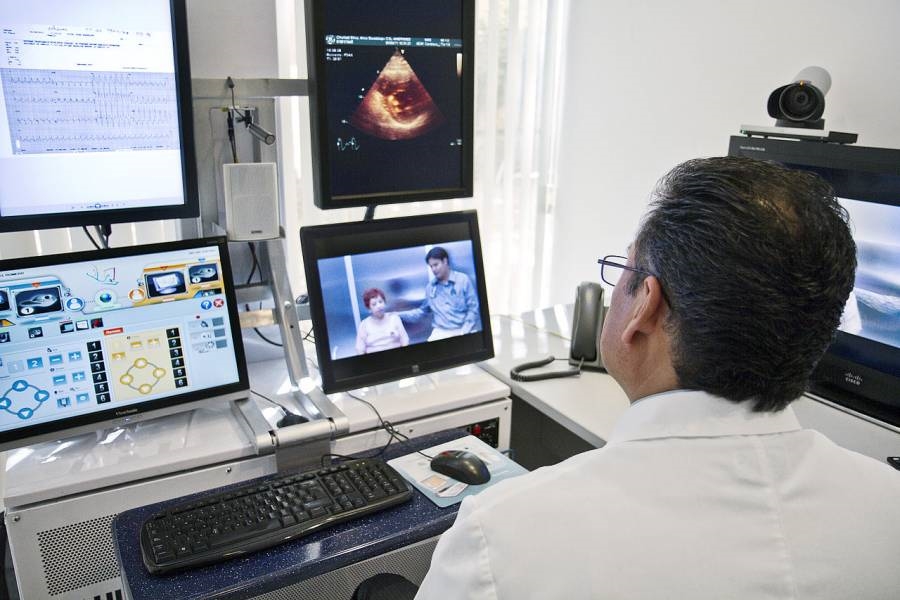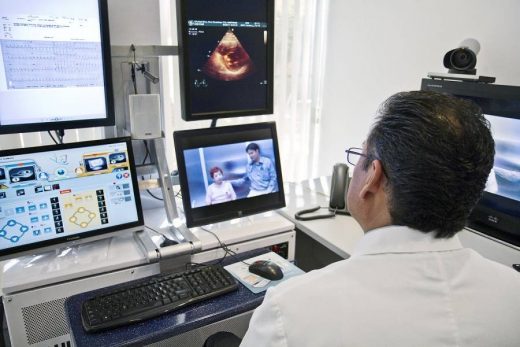The Future of Telehealth: Challenges and Solutions for the Medical Industry
The Future of Telehealth: Challenges and Solutions for the Medical Industry

The future of telehealth is here and now, accelerated by the Covid-19 pandemic. According to the Center for Disease Control (CDC), telehealth visits increased by 154% in 2020, compared to 2019. And one year later, there’s little surprise as to why.
The Future of Telehealth: Challenges and Solutions for the Medical Industry
As the coronavirus continues to make headlines worldwide, many health professionals have turned to telehealth solutions. Virtual care benefits don’t just help decrease contamination risk and reduce exposure for patients and staff.
They also include a decrease in on-site patient demand and facilitate widespread access to healthcare solutions. This has proven to be life-saving, especially for more vulnerable individuals at this unstable time.

Image source: Storyset
The road to success is windy, and the innovative world of telehealth is not without its disadvantages. The medical industry has had to rush to adjust to this new reality. Often with little time to address the challenges or find creative solutions.
As a result, more than ever before, institutions, hospitals, governments, and all types of healthcare providers are discussing telehealth benefits and challenges.
If you’re trying to keep your patients safe and your practice afloat, you must understand the future of telehealth so you can plan how to make the transition with success.
What Is Telehealth and What Is Telemedicine?
Telehealth can be defined as using telecommunication technologies (such as computers or mobile devices) to facilitate health-related services. These services include medical care, patient education and monitoring, and also telemedicine.
Telemedicine is a more specific term to describe patients’ diagnosis, treatment, and consultation via digital technologies.
Telehealth Benefits and Challenges
The pandemic increased the demand for digital and remote health-related services to unprecedented levels. However, it also highlighted telehealth benefits and challenges in a more transparent way. Let’s take a closer look at these challenges and advantages.
Main Advantages of Telehealth
The benefits of telehealth go far beyond preventing exposure to viruses and diseases. As doctors and patients transition into the digital world, more and more benefits become evident. Patients and physicians no longer need to be in the same city or even state to attend a consultation.
Those who live in rural areas or have mobility issues can better access healthcare services without leaving their homes.
The future of telehealth is also beneficial to busy parents and professionals who have little time for in-person visits. As a healthcare professional, this allows you to reach more patients, grow your practice, and sustainably increase your revenue.

Image source: Pixabay
Streamlining consultations between doctors and patients is just the beginning. Health institutions of all sizes and types are adopting telehealth in their practices. Here are just a few reasons why:
- Monitoring all types of conditions can be more consistent through the use of technology.
- Patients can log their symptoms into applications and safely share them with doctors.
- Physicians can review and interpret medical imaging scans or blood test results through digital communication.
Whether it’s for remote patient monitoring, mobile health via smart devices, or the use of ingestible sensors — technology-centric healthcare is here to stay. You can now get data from IoT devices during telemedicine appointments and monitor your patients in real-time. Adopting telehealth can demand a hefty initial investment, but you can expect reduced costs in the mid and long term.
Telemedicine Risks and Challenges – And How to Overcome Them
With every new trend comes new challenges. Many physicians and owners of healthcare institutions are tentative about investing in their own solution because they are worried about the risks. However, if done correctly, medical technology should empower you and your healthcare practice to reach new heights and conquer new horizons.
Challenge: Receiving Payment and Reimbursement
Getting payment from customers online can be a challenge for teams and institutions. Private and public health insurance companies like Medicare used to have restrictions for coverage of telehealth consultations.
However, during the Covid-19 pandemic, most of these restrictions were lifted by the government for Medicare. Therefore, opening the opportunity for insurance providers. With this limitation removed, it has now become easier for healthcare institutions to receive payments or reimbursements.
Solution: Set Up Technology for Integration and Tracking
When looking for a tech partner to bring your healthcare service to the digital world, you should request that payment solutions are integrated into your current EMR/EHR system.
With the right technology, you can keep track of all reimbursement claims and organize receipts. For example, when a patient schedules a consultation via your EMR/EHR system, you can set it up to automatically track their insurance coverage.
This means that your system would send a payment request to the patient or a reimbursement claim to their insurance provider on the day of the consultation.
Challenge: Keeping Sensitive Patient Data Safe
Privacy is a significant concern for both patients and providers when it comes to health information. You must ensure that all communication ends are protected and encrypted – even on the patient side. Cyber-attacks can happen on either end, raising concern about data privacy.
Solution: Hire a Third-Party Provider with Experience in Data Privacy
Josip Radic, Deputy Director of Engineering at Scopic, explains that a third-party software development company should have experience with data privacy and HIPAA compliance. “Data in healthcare systems can be very sensitive, so healthcare companies have to take all necessary steps to prevent any type of data leakage,” Josip adds.
Most healthcare providers work closely with government agencies that regulate security guidelines and stipulate best practices. Third-party security agencies can also audit your applications to evaluate the quality of your safety implementations.
However, it is better to play it safe and have security measures in place before the audit, and other regulatory processes occur.
Challenge: Handling Massive Amounts of Patient Data
Depending on the telehealth services you offer, you may be dealing with massive amounts of data daily — from medical imaging scans and videos to patient records, and other vital information.
Managing lots of sensitive patient data is an enormous challenge and requires particular know-how and experience. The responsibility of storing such data can be a daunting problem, especially when considering the importance of information security.
Solution: Big Data Expertise and Serverless Settings
As a solution to this challenge, you should look for a dependable third-party software development partner. Focus on finding a company with vast expertise in big data and deep know-how on patient data privacy.
Another layer of data security you should consider for your application is avoiding servers. “Architect your solution in a ‘serverless’ way. This will mean you can transfer responsibilities to cloud platforms (if the software is cloud-based) or other companies that take care of system updates, maintenance, and upgrades,” Josip explains.
Challenge: Patient Retention and Digital Literacy
Transitioning your practice to digital can be a challenge. Often, a lack of digital literacy can cause patients to abandon their applications early on. You need to create accessible, flexible, and easy-to-use solutions so patients can access the app on the go from wherever they are. Ultimately, if your solution is too complicated or lacks usability, you can end up losing patients.
Solution: Invest in User Experience and Responsiveness
Sometimes, the best way to enhance patient care and streamline communication is to tailor-make your own solution. By doing so, you can create applications that fit your specific needs and overcome your pain points.
Start by considering your goals and challenges and draw up a plan of action. Make sure to research the solutions your competition is using and seek the advice of an expert.
Don’t forget to think mobile! Statistics show that more people are accessing healthcare services through their phones. Mobile applications should be a part of the solution when caring for patients and enabling communication. Your telemedicine app should not only be safe and fast but also available for any type of screen – from desktop to tablets to mobile devices.
User experience is also key. Your application must be intuitive and easy to navigate for both professionals and end-users. Enabling real-time communication to help save lives and boost patient satisfaction is not an easy task. So, make sure you are equipped with the knowledge and team you need to reach your goals.

Image source: Wikimedia Commons.
The Future of Telehealth is Upon Us. Are You Ready?
The year 2020 brought telehealth to a level that many thought would take decades, yet here we are. We still don’t know what telemedicine will look like in a few years, but we have some ideas.
The challenges are significant, but the solutions are viable. You should embrace all the benefits of bringing your medical solutions into the digital world. Partnering with a dependable software development company will help you bring your telehealth ideas to life. If your practice is ready to shape the future of patient care, telehealth solutions (scopicwoftwaredotcom) are the way to go forward.
Top Image Credit: edward jenner; pexels; thank you!
The post The Future of Telehealth: Challenges and Solutions for the Medical Industry appeared first on ReadWrite.
(26)


